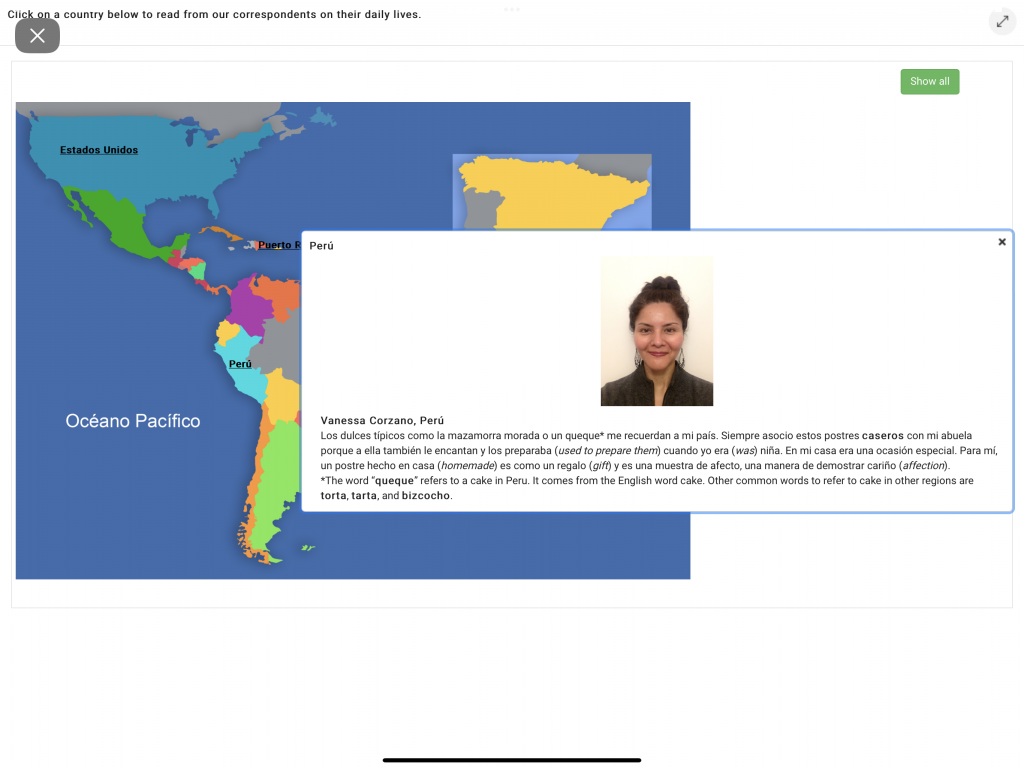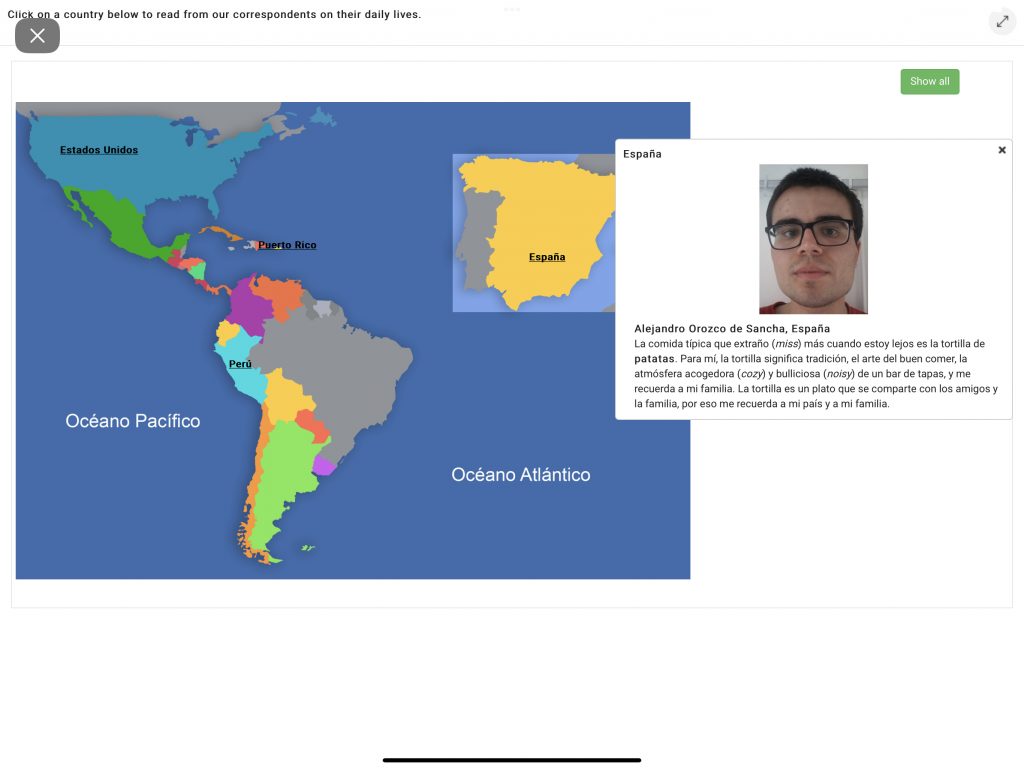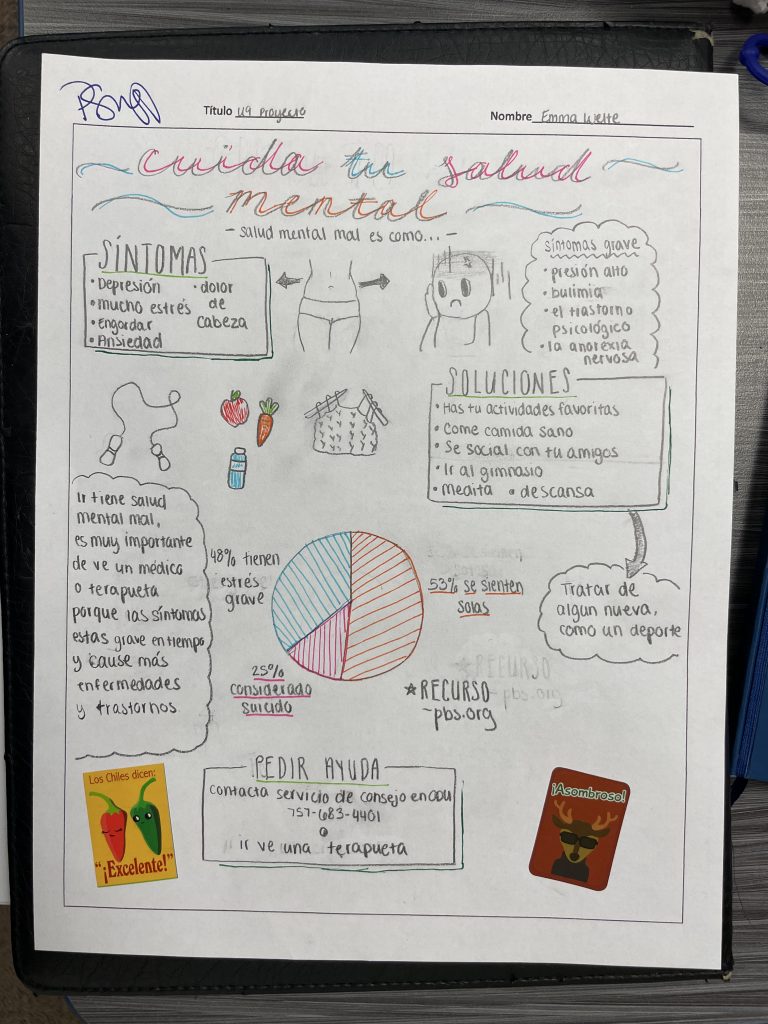Interpretive, Interpersonal, and Presentational Modes of Communication
Exploring Culture
Throughout Contraseña, there were sections within each unit that offered details about their collaborators’ countries and accompanying cultures. There would be descriptions of what was or was not typical, what was changing in their country, what traditions were, etc.
The collaborator sections helped me to be able to apply what I was learning throughout the units. While we’re learning the “proper” form of the language, within it there are so many different subcultures and dialects, so it’s important to learn about these because each has their own unique identity that they would want recognized and respected. It helped me to realize what was a common theme between different Hispanic/Latino cultures, as well as what was different, even if they were close in proximity. The collaborator sections helped me better value and understand the unique traditions and values of different cultures and use what I have learned to reflect differently on my own culture and apply those values I connect with. It helped me to feel more connected to the language I’m learning, and thus the people that I will come across who speak it. It also helps me feel prepared for when I travel to Spanish-Speaking countries, as I won’t feel so disconnected and I’ll have an understanding of my surroundings and the native citizens.


Engaging in Communities
My current occupation is retail, however my career will be in education. Being able to speak and understand as much Spanish as possible is important because I encounter Spanish-Speakers daily at work, and I feel they can receive better assistance and service when I can communicate in a way they are more comfortable with. In my future career of teaching, I undoubtedly will have students that are ESL students with Spanish as their first language. Breaking through the language barrier will help them feel more comfortable in my classes and hopefully in school, and I can ensure they get the same quality of education as their English-speaking peers.

Interpersonal Communication
TalkAbroad was a unique opportunity to communicate with Spanish-Speakers who are from other countries through the internet. These partners were familiar with the material we had learned so far and did a wonderful job of not using vocabulary, slang, or grammar that we were not educated on yet. This was especially helpful for students who don’t know Spanish-Speakers in their personal lives.
While it could be a little nerve wracking sometimes, I feel I benefited the most from communication activities within the classroom, as we had the opportunity to provide feedback to our partners and practice hearing and saying new vocabulary and grammar. Of course, TalkAbroad was the most challenging and demanding, as there were no “retakes” or starting over, but they were also very beneficial and the partners were very patient. I feel I’ve grown more confident the more I practiced, and I didn’t feel too intimidated to try putting together new sentences and utilizing the new things I learned. The most difficult thing to overcome was all the different forms of each word and subject! Remembering all those can be challenging, but the repetition was integral. If I were to do the class again, I would spend more time speaking out loud, even alone, just to get the practice of saying different sentences and words.
(I couldn’t find a good clear moment in the TalkAbroad to include, as I was fumbling for words more than I realized)
Presentational Speaking
We had two presentational speaking projects, which required us to describe our family and friends’ physical and personal characteristics as well as their relationships, and to describe the preparation, steps, ingredients, and extra details such as when and where we ate it, about a dish of our choosing.
The most difficult part about the family presentation was finding enough different descriptors to talk about that wouldn’t get repetitive, such as listing each person’s hair and eye color. Once I thought about what was unique about that person, it became easier to focus on coming up with varying details.
The most difficult part about the food presentation was coming up with complete sentences in a guiding format. It took me a little bit of time to write out and practice everything I wanted to say and made sure it made sense. When I practiced with Spanish-Speakers, to my surprise most of it was correct! That helped give me the confidence to trust my instincts and keep going.
Presentational Writing
One of the presentational writing projects we had to do was about mental, physical, and social health issues that affect college students, what causes them, and how to fix them and maintain good health.

Initially, this assignment seemed intimidating as the information I wanted to include contained vocabulary I wasn’t familiar with yet. Once I planned out my talking points and broke down the assignment, it became easier to organize my information correctly. The grammar wasn’t too challenging since it was just commands. I feel this assignment was appealing to create because I tend to do best when I have free reign over the aesthetics of an assignment, since I like to be artsy.
Interpretive Listening
Throughout Contraseña, many units and activities required listening to passages or dialogues related to the learning material. We would then have to answer questions that were either true or false about a statement, select appropriate responses, select the correct summary, etc.
The most difficult part was the fact I couldn’t read what I was listening to, and personally some letters, words, or syllables sound too similar, for example “cat” and “bat” in English. I had to listen to audio repeatedly and even repeat it back to myself sometimes, which would help me to be sure of those minor differences. It also helped me to break down a full paragraph of speech better and understand it in digestible pieces.
Interpretive Reading
The reading we had to interpret could range from text message exchanges, emails, posters, advertisements, and descriptions of products, services, clubs, and activities. In these reading activities, we would sometimes have to answer prompts about what we read, answer true or false statements, or select correct responses or summaries. In the example of the picture below, we would occasionally have to select words in relation to a certain grammatical concept we were learning about, and the surrounding context would provide us with the clues and information we needed to select the correct words.

This reading could be challenging at times as it would throw a lot of new vocabulary and grammar at us, so I would have to use translation assistance to understand what was written. I didn’t translate every word, but the surrounding words of prompts or fill in the blanks could be challenging at times. However, this was the best way for me to learn new words, as this forced me to apply them to the question at hand.